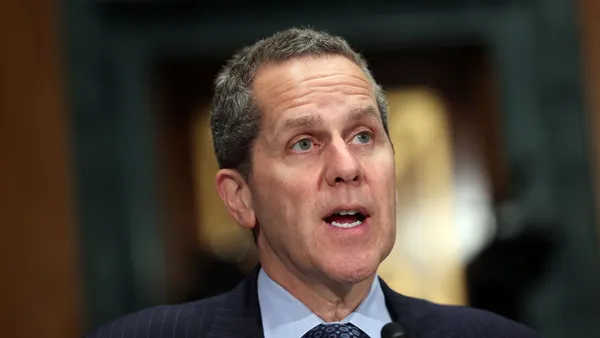Dive Brief:
- Wells Fargo has missed out on about $4 billion in profits since the Federal Reserve capped the bank’s assets at $1.95 trillion, Bloomberg estimated based on what the San Francisco-based lender could have earned if its assets grew at the same rate and profitability as its competitors.
- The cap is limiting the bank’s options such that it is reacting differently to changes in the economic climate. The Fed’s decision to lower interest rates in the early days of the coronavirus pandemic may have spurred the bank to add loans to offset the impact on earnings. Net interest income fell 18% in the second quarter at the bank, but that loss could have been cut in half if the bank were allowed to expand its balance sheet, CFO John Shrewsberry said.
- Wells Fargo’s management team and board are due by next month to submit a plan, detailing proposed business changes, that may prompt the Fed to lift the cap — provided the regulator accepts it and a third-party review is completed. The Fed rejected Wells’s first such plan two years ago, sources told Bloomberg. The bank told the Fed it wouldn’t hit an April deadline to submit a new plan. Wells, however, expects to meet the September time frame, sources told the wire service.
Dive Insight:
The open-ended nature of the asset cap may lend to its appearance as a harsh punishment. “If it had been a one-year deal, it would’ve been inconvenient and somewhat painful but not draconian,” Arthur Wilmarth, a law professor at George Washington University, told Bloomberg. “But after two and a half years, you’d have to say it begins to look very draconian.”
Neither Fed officials nor Wells Fargo’s leaders at first expected such a long-lasting restriction, sources told Bloomberg. When the cap was first imposed in February 2018, executives estimated the bank would satisfy the requirements to lift the cap by the end of the year. Former CEO Tim Sloan later extended that timeline, then resigned — prompting the bank to stop estimating an end date.
Charles Scharf, in his first earnings call as Wells Fargo’s CEO, said in January the bank may take “much of this year” to review its budget and broader business.
The $4 billion estimate for missed profits assumes Wells Fargo’s asset growth meets the industry average — and it doesn’t include what the bank is spending to revamp its operations. Scharf said in July he was looking to trim $10 billion from the bank’s annual expenses. Some of that could be made up by cutting consultancies. But more could come from reducing headcount by tens of thousands. The bank said last week it began a long-anticipated round of job cuts this month.
Complicating the economic picture is the coronavirus pandemic, which forced banks to set aside billions of dollars for expected loan losses and pushed Wells to its first quarterly loss since 2008.
In the pandemic’s early days, the bank asked the Fed to lift the asset cap temporarily so it could facilitate more loans through the Paycheck Protection Program (PPP). The Fed obliged, but the cap continues taking a toll, costing the bank $220 billion in market value, Bloomberg estimated in May.
Wells Fargo began the year with 12 enforcement actions against it. Often, when a number of regulators investigate a bank on interconnected matters, banks reach a mass settlement with a single price tag. For example, when Bank of America reached a 2014 settlement over its mortgage practices, the payout to individual regulators was a fraction of the $17 billion total.
Since the Fed imposed its asset cap, Wells Fargo has twice taken penalties in the billions of dollars — a $3 billion settlement with the Justice Department and Securities and Exchange Commission for the bank’s 2016 fake accounts scandal, and a $1 billion settlement with the Consumer Financial Protection Bureau and the Office of the Comptroller of the Currency.
“The Federal Reserve will determine when the work is done to their satisfaction,” Wells Fargo said in a statement.
A Fed representative declined to comment to Bloomberg.














